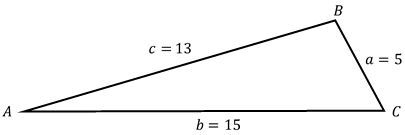A surveyor wishes to find the distance across a river while standing on a small island. If she measures distances of to one shore, to the opposite shore, and an angle of between the two shores, find the distance between the two shores.
Table of contents
- 0. Fundamental Concepts of Algebra3h 32m
- 1. Equations and Inequalities3h 27m
- 2. Graphs1h 43m
- 3. Functions & Graphs2h 17m
- 4. Polynomial Functions1h 54m
- 5. Rational Functions1h 23m
- 6. Exponential and Logarithmic Functions2h 28m
- 7. Measuring Angles40m
- 8. Trigonometric Functions on Right Triangles2h 5m
- 9. Unit Circle1h 19m
- 10. Graphing Trigonometric Functions1h 19m
- 11. Inverse Trigonometric Functions and Basic Trig Equations1h 41m
- 12. Trigonometric Identities 2h 34m
- 13. Non-Right Triangles1h 38m
- 14. Vectors2h 25m
- 15. Polar Equations2h 5m
- 16. Parametric Equations1h 6m
- 17. Graphing Complex Numbers1h 7m
- 18. Systems of Equations and Matrices3h 6m
- 19. Conic Sections2h 36m
- 20. Sequences, Series & Induction1h 15m
- 21. Combinatorics and Probability1h 45m
- 22. Limits & Continuity1h 49m
- 23. Intro to Derivatives & Area Under the Curve2h 9m
13. Non-Right Triangles
Law of Cosines
Struggling with Precalculus?
Join thousands of students who trust us to help them ace their exams!Watch the first videoMultiple Choice
Solve the triangle: a=5, b=15, c=13.

A
A=18.9°,B=103.8°,C=57.3°
B
A=13.8°,B=108.9°,C=57.3°
C
A=13.8°,B=103.8°,C=62.4°
D
A=18.9°,B=98.7°,C=62.4°
 Verified step by step guidance
Verified step by step guidance1
Identify the given sides of the triangle: a = 5, b = 15, c = 13.
Use the Law of Cosines to find one of the angles. For example, to find angle A, use the formula: cos(A) = (b^2 + c^2 - a^2) / (2bc).
Substitute the values into the formula: cos(A) = (15^2 + 13^2 - 5^2) / (2 * 15 * 13).
Calculate the value of cos(A) and then use the inverse cosine function to find angle A.
Repeat the process using the Law of Cosines to find another angle, such as angle B, and then use the fact that the sum of angles in a triangle is 180° to find the third angle, C.

 4:35m
4:35mWatch next
Master Intro to Law of Cosines with a bite sized video explanation from Patrick
Start learningRelated Videos
Related Practice
Multiple Choice
1
comments


